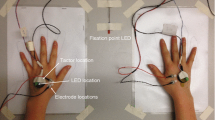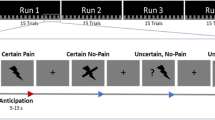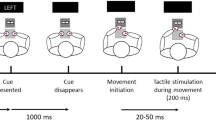Abstract
Perceived pain intensity is modulated by attention. However, it is not known that how pain intensity ratings are affected by attention in capsaicin-induced secondary hyperalgesia. Here we show that perceived pain intensity in secondary hyperalgesia is decreased when attention is distracted away from the painful pinprick stimulus with a visual task. Furthermore, it was found that the magnitude of attentional modulation in secondary hyperalgesia is very similar to that of capsaicin-untreated, control condition. Our findings, showing no interaction between capsaicin treatment and attentional modulation suggest that capsaicin-induced secondary hyperalgesia and attention might affect mechanical pain through independent mechanisms.


Similar content being viewed by others
References
Ali Z, Meyer RA, Campbell JN (1996) Secondary hyperalgesia to mechanical but not heat stimuli following a capsaicin injection in hairy skin. Pain 68:401–411
Al-Obaidi SM, Nelson RM, Al-Awadhi S, Al-Shuwaie N (2000) The role of anticipation and fear of pain in the persistence of avoidance behavior in patients with chronic low back pain. Spine 25:1126–1131
Apkarian AV, Sosa Y, Krauss BR, Thomas PS, Fredrickson BE, Chialvo DR et al (2004) Chronic pain patients are impaired on an emotional decision-making task. Pain 108:129–136
Baumgärtner U, Magerl W, Klein T, Hopf HC, Treede RD (2002) Neurogenic hyperalgesia versus painful hypoalgesia: two distinct mechanisms of neuropathic pain. Pain 96:141–151
Bushnell MC, Duncan GH, Dubner R, Jones RL, Maixner W (1985) Attentional influences on noxious and innocuous cutaneous heat detection in humans and monkeys. J Neurosci 5:1103–1110
Del Percio C, Le Pera D, Arendt-Nielsen L, Babiloni C, Brancucci A, Chen AC, De Armas L et al (2006) Distraction affects frontal alpha rhythms related to expectancy of pain: an EEG study. Neuroimage 31:1268–1277
Eccleston C, Crombez G (1999) Pain demands attention: a cognitive-affective model of the interruptive function of pain. Psychol Bull 125:356–366
Houlihan ME, McGrath PJ, Connelly JF, Stroink G, Finley GA, Dick B et al (2004) Assessing the effect of pain on demands for attentional resources using ERP’s. Int J Psychophysiol 51:181–187
Klede M, Handwerker HO, Schmelz M (2003) Central origin of secondary mechanical hyperalgesia. J Neurophysiol 90:353–359
Klein T, Magerl W, Rolke R, Treede RD (2005) Human surrogate models of neuropathic pain. Pain 115:227–233
Koltzenburg M, Torebjörk HE, Wahren LK (1994) Nociceptor modulated central sensitization causes mechanical hyperalgesia in acute chemogenic and chronic neuropathic pain. Brain 117:579–591
Kovács G, Zimmer M, Harza I, Antal A, Vidnyánszky Z (2005) Position-specificity of facial adaptation. Neuroreport 16:1945–1949
Kovács G, Zimmer M, Bankó E, Harza I, Antal A, Vidnyánszky Z (2006) Electrophysiological correlates of visual adaptation to faces and body parts in humans. Cereb Cortex 16:742–753
Lee MC, Zambreanu L, Menon DK, Tracey I (2008) Identifying brain activity specifically related to the maintenance and perceptual consequence of central sensitization in humans. J Neurosci 28:11642–11649
Levine JD, Gordon NC, Smith R, Fields HL (1982) Postoperative pain: effect of extent of injury and attention. Brain Res 234:500–504
Maihöfner C, Handwerker HO (2005) Differential coding of hyperalgesia in the human brain: a functional MRI study. Neuroimage 4:996–1006
Maihöfner C, Forster C, Birklein F, Neundörfer B, Handwerker HO (2005) Brain processing during mechanical hyperalgesia in complex regional pain syndrome: a functional MRI study. Pain 114:93–103
McCaul KD, Malott JM (1984) Distraction and coping with pain. Psychol Bull 95:516–533
Miron D, Duncan GH, Bushnell MC (1989) Effects of attention on the intensity and unpleasantness of thermal pain. Pain 39:345–352
Moulton EA, Pendse G, Morris S, Strassman A, Aiello-Lammens M, Becerra L et al (2007) Capsaicin-induced thermal hyperalgesia and sensitization in the human trigeminal nociceptive pathway: an fMRI study. Neuroimage 35:1586–1600
Patil PG, Apfelbaum JL, Zacny JP (1995) Effects of a cold-water stressor on psychomotor and cognitive functioning in humans. Physiol Behav 58:1281–1286
Petersen KL, Rowbotham MC (1999) A new human experimental pain model: the heat/capsaicin sensitization model. Neuroreport 10:1511–1516
Pfingsten M, Leibing E, Harter W, Kröner-Herwig B, Hempel D, Kronshage U et al (2001) Fear-avoidance behavior and anticipation of pain in patients with chronic low back pain: a randomized controlled study. Pain Med 2:259–266
Quevedo AS, Coghill RC (2007) Attentional modulation of spatial integration of pain: evidence for dynamic spatial tuning. J Neurosci 27:11635–11640
Raja SN, Campbell JN, Meyer RA (1984) Evidence for different mechanisms of primary and secondary hyperalgesia following heat injury to the glabrous skin. Brain 107:1179–1188
Rode S, Salkovskis PM, Jack T (2001) An experimental study of attention, labelling and memory in people suffering from chronic pain. Pain 94:193–203
Schmidt R, Schmelz M, Forster C, Ringkamp M, Torebjörk E, Handwerker H (1995) Novel classes of responsive and unresponsive C nociceptors in human skin. J Neurosci 15:333–341
Simone DA, Baumann TK, LaMotte RH (1989) Dose-dependent pain and mechanical hyperalgesia in humans after intradermal injection of capsaicin. Pain 38:99–107
Torebjörk HE, Lundberg LE, LaMotte RH (1992) Central changes in processing of mechanoreceptive input in capsaicin-induced secondary hyperalgesia in humans. J Physiol 448:765–780
Treede RD, Magerl W (2000) Multiple mechanisms of secondary hyperalgesia. Prog Brain Res 129:331–341
Treede RD, Meyer RA, Raja SN, Campbell JN (1992) Peripheral and central mechanisms of cutaneous hyperalgesia. Prog Neurobiol 38:397–421
Treede RD, Rolke R, Andrews K, Magerl W (2002) Pain elicited by blunt pressure: neurobiological basis and clinical relevance. Pain 98:235–240
Veldhuijzen DS, Kenemans JL, de Bruin CM, Olivier B, Volkerts ER (2006) Pain and attention: attentional disruption or distraction? J Pain 7:11–20
Vlaeyen JW, Linton SJ (2000) Fear-avoidance and its consequences in chronic musculoskeletal pain: a state of the art. Pain 85:317–332
Wiech K, Seymour B, Kalisch R, Stephan KE, Koltzenburg M, Driver J et al (2005) Modulation of pain processing in hyperalgesia by cognitive demand. Neuroimage 27:59–69
Zambreanu L, Wise RG, Brooks JC, Iannetti GD, Tracey I (2005) A role for the brainstem in central sensitisation in humans. Evidence from functional magnetic resonance imaging. Pain 114:397–407
Ziegler EA, Magerl W, Meyer RA, Treede RD (1999) Secondary hyperalgesia to punctate mechanical stimuli. Central sensitization to A-fibre nociceptor input. Brain 122:2245–2257
Acknowledgments
We are grateful to Csaba Nemes for his help in developing the stimulus presentation program. This research was partly supported by the Richter Gedeon Ltd. These experiments were realised using Cogent Graphics developed by John Romaya at the LON at the Wellcome Department of Imaging Neuroscience.
Author information
Authors and Affiliations
Corresponding author
Rights and permissions
About this article
Cite this article
Kóbor, I., Gál, V. & Vidnyánszky, Z. Attentional modulation of perceived pain intensity in capsaicin-induced secondary hyperalgesia. Exp Brain Res 195, 467–472 (2009). https://doi.org/10.1007/s00221-009-1799-0
Received:
Accepted:
Published:
Issue Date:
DOI: https://doi.org/10.1007/s00221-009-1799-0




